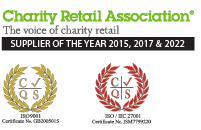
How your charity can be more environmentally conscious
As a charity, you’re already doing a lot of good. You’re automatically a pro-social cause, whether what you do is for the poor, the sick, animals, or anything in this vast spectrum. But when it comes to the environment, everyone in the third sector can play their part.
There are small changes that can make a big difference. But outside of the obvious, such as recycling paper, how can you help? We have a few suggestions on how to reduce your carbon footprint and “go green”, so let’s dive right in.
Reduce your paperwork
It almost feels like paperwork is an annoying yet mandatory part of any organisation. But there’s been a push in recent years to go paperless. And even if you’re swimming in administrative work, it’s very much possible to do.
So much of our work can be done digitally now. Even more so, it can be put onto a shared, cloud-based system, meaning people from across your organisation can access relevant documents whenever they need to. Let’s use an example donor. Instead of a printed Gift Aid declaration form, it can be done digitally. This is then saved in the system for when that specific donor returns.
Then you can go a step further. That can all be logged in the same system, and an area manager can access that data on the go to see how many donations take advantage of Gift Aid. It all feeds together in a way that paperwork never could. It also just so happens to have the added benefit of cutting down on paper.
Make every donation count
There are also plenty of ways you can make the most of your donations. Or ways you can influence what donations come through your door and hopefully prevent having to throw them away.
Clothes unfit for purpose can be great as rags, which can also be used to raise funds. If you’re doing this, then make sure you get Gift Aid on those sales. When you’re finding it hard to shift stock, you can look at online sales if you already aren’t. This broadens your reach and can help you find homes for your items across the country. It’s simple enough to integrate eBay pages with your stock levels, assuming you have the right EPoS system.
You could also send out a newsletter or news shot to your donors letting them know what you aren’t accepting. This ensures you aren’t inundated with types of items you don’t have the capacity to sell. For example, you could send out a newsletter (via email, to save on the paper) letting people know you aren’t accepting clothes because you have too many. But that you are looking for more books. Tailoring your donations saves on unnecessary waste.
Use less energy
This might seem like a basic environmentally friendly tip, but one worth repeating. Think about how you can reduce the energy you use. In your shops, this might mean changing what light bulbs you use, for example. LED bulbs last 10 times longer and use 85% less electricity.
Another one to think about is your work-from-home policy (where applicable). While it’s nice to have everyone back in the office, that could mean more cars on the road, which puts more CO2 into the atmosphere. By encouraging people to commute less, you’re contributing to cutting back on carbon emissions. For more advice on saving energy in your organisation, the Carbon Trust has a useful guide on the topic.
As they say, every little helps. In the fight against climate change, we can all contribute a little more. These are just a handful of ways your charity can do its part beyond what it already does.
Doing the right thing for the environment means making sure you’re at the cutting edge of technology. The latest solutions will be more effective and efficient than what came before. For an industry-leading EPoS system that makes it easier to be digital, get in touch with our team on 01204 706000.
Share this:

With over thirty years of experience developing EPoS systems, Nisyst is a family-owned business whose main mission is to make technology work harder for the charity sector.

Quick links
© 2022 All rights reserved Nirvana Intelligent Systems Ltd. Website designed & developed by evokeu